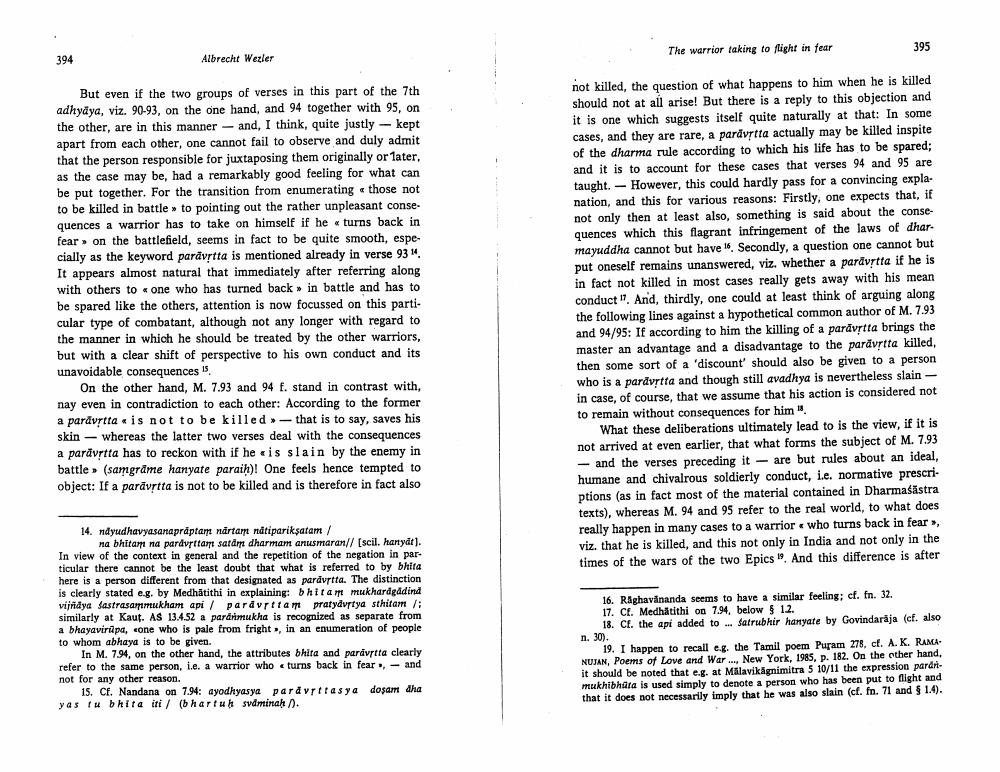________________
Albrecht Wezler
The warrior taking to fight in fear
395
But even if the two groups of verses in this part of the 7th adhyaya, viz. 90-93, on the one hand, and 94 together with 95, on the other, are in this manner - and, I think, quite justly - kept apart from each other, one cannot fail to observe and duly admit that the person responsible for juxtaposing them originally or later, as the case may be, had a remarkably good feeling for what can be put together. For the transition from enumerating those not to be killed in battle to pointing out the rather unpleasant consequences a warrior has to take on himself if he turns back in fear on the battlefield, seems in fact to be quite smooth, espe. cially as the keyword parāvetta is mentioned already in verse 93 It appears almost natural that immediately after referring along with others to one who has turned back in battle and has to be spared like the others, attention is now focussed on this particular type of combatant, although not any longer with regard to the manner in which he should be treated by the other warriors, but with a clear shift of perspective to his own conduct and its unavoidable consequences
On the other hand, M. 7.93 and 94 f. stand in contrast with, nay even in contradiction to each other: According to the former a pardvytta is not to be killed that is to say, saves his skin - whereas the latter two verses deal with the consequences a pardurtta has to reckon with if he is slain by the enemy in battle (samgrame hanyate paraih)! One feels hence tempted to object: If a pardvętta is not to be killed and is therefore in fact also
not killed, the question of what happens to him when he is killed should not at all arise! But there is a reply to this objection and it is one which suggests itself quite naturally at that: In some cases, and they are rare, a parāvŢtta actually may be killed inspite of the dharma rule according to which his life has to be spared; and it is to account for these cases that verses 94 and 95 are taught. - However, this could hardly pass for a convincing explanation, and this for various reasons: Firstly, one expects that, if not only then at least also, something is said about the consequences which this flagrant infringement of the laws of dhar mayuddha cannot but have 15. Secondly, a question one cannot but put oneself remains unanswered, viz. whether a pardvytta if he is in fact not killed in most cases really gets away with his mean conduct. And, thirdly, one could at least think of arguing along the following lines against a hypothetical common author of M. 7.93 and 94/95: If according to him the killing of a pardvetta brings the master an advantage and a disadvantage to the pardvrtta killed, then some sort of a 'discount should also be given to a person who is a pardvera and though still avadhya is nevertheless slainin case, of course, that we assume that his action is considered not to remain without consequences for him"
What these deliberations ultimately lead to is the view, if it is not arrived at even earlier, that what forms the subject of M. 7.93 - and the verses preceding it - are but rules about an ideal, humane and chivalrous soldierly conduct, i.e. normative prescriptions (as in fact most of the material contained in Dharmasastra texts), whereas M. 94 and 95 refer to the real world, to what does really happen in many cases to a warrior who turns back in fear, viz. that he is killed, and this not only in India and not only in the times of the wars of the two Epics". And this difference is after
14. ndyudhavyasanapraptar ndrtar nåtipariksatam/
na bhitari na parduritasard dharmam arusmaran// (scil. hantyde). In view of the context in general and the repetition of the negation in par ticular there cannot be the least doubt that what is referred to by bhlia here is a person different from that designated as paravatta. The distinction is clearly stated eg, by Medhatithi in explaining hita mukhardgddind vijfidya Sastrasamirkham api / pardvrtiam pratydvrtya sthitam : similarly at Kauf. AS 134.52 a pardrimukha is recognized as separate from a bhayavirapa, one who is pale from fright, in an enumeration of people to whom abhaya is to be given.
In M. 7.94, on the other hand, the attributes bhita and pardytta clearly refer to the same person, i.e. a warrior who turns back in fear, and not for any other reason.
15. Cl. Nandana on 7.94: ayodhyasya paravritas ya dosarri dha yas tu bhita iti/ (bhartuh sydminah .
16. Raghavananda seems to have a similar feeling: cf. fr. 32. 17. Cf. Medhatithi on 7.94, below 12.
18. Cf. the api added to ... Satrubhir hanyate by Govindaraja (cf. also n. 30).
19. I happen to recall eg the Tamil poem Puram 278, cf. A. K. RAMANUJAN, Poems of Love and War... New York, 1985, p. 182. On the other hand, it should be noted that e.g. at Malavikāgnimitra 5 10/11 the expression pardt mukhibhdra is used simply to denote a person who has been put to flight and that it does not necessarily imply that he was also slain (cf. fn. 71 and $ 1.4).




